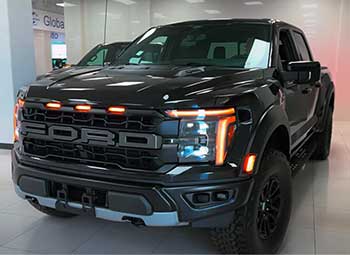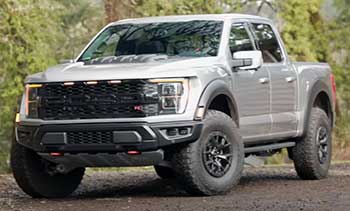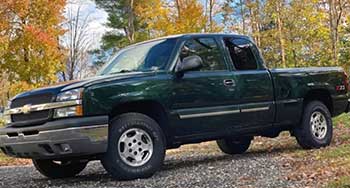
I’ve spent countless hours behind the wheel of both the Ford Raptor and the Toyota Tundra TRD Pro, tackling everything from desert trails to city streets.
My goal in this article is to share my firsthand experiences, breaking down the strengths, weaknesses, and key features of these two off-road titans.
Whether you’re an adventure junkie or just need a reliable truck, I’ll help you decide which one suits your lifestyle.
With detailed pros, cons, and maintenance tips, plus a comparison table, you’ll get a clear picture of what each truck brings to the table.
Comparison Table
| Feature | Ford Raptor | Toyota Tundra TRD Pro |
|---|---|---|
| Engine | 3.5L EcoBoost V6, 450 hp, 510 lb-ft | 3.5L i-Force Max Hybrid V6, 437 hp, 583 lb-ft |
| Suspension | Fox Live Valve shocks, 14” front/15” rear travel | Fox 2.5” shocks, 8” front/10” rear travel |
| Tires | 35” or 37” BFGoodrich All-Terrain | 33” Falken WildPeak A/T |
| Ground Clearance | 12.0 inches | 10.9 inches |
| Approach Angle | 31.0 degrees | 26.2 degrees |
| Towing Capacity | 8,200 lbs | 11,175 lbs |
| Price (Starting) | $78,720 | $67,235 |
| Reliability | Moderate, complex systems | High, simpler design |
| Off-Road Tech | Trail Control, Trail Turn Assist | Crawl Control, Multi-Terrain Select |
| Interior | Premium, 12” touchscreen | Functional, 14” touchscreen |
My Experience With Ford Raptor

I’ll never forget the first time I took a Ford Raptor off-road.
It was like piloting a spaceship through the desert—powerful, responsive, and just plain fun.
The Raptor’s 3.5-liter EcoBoost V6 pumps out 450 horsepower, and the 510 pound-feet of torque made quick work of steep inclines and sandy washes.
Its wide stance and Fox Live Valve shocks absorbed every bump like it was nothing, with 14 inches of front suspension travel and 15 inches in the rear. On the highway, it’s surprisingly smooth for such a beast, though the cabin’s premium materials and 12-inch touchscreen felt almost too luxurious for a truck built to get dirty.
Off-road, the Raptor shines with features like Trail Control, which acts like an off-road cruise control, letting me focus on steering while the truck handles speed. Trail Turn Assist, a feature that tightens the turning radius by dragging the inside rear tire, was a game-changer in tight trails. But it’s not perfect.
The Raptor’s thirst for fuel—averaging about 15 MPG—hit my wallet hard, and its higher price tag made me wince. Maintenance costs can also creep up, especially with its complex suspension and turbocharged engine. Still, every time I floored it, the grin on my face was worth it.
On the flip side, the Raptor’s size can feel unwieldy in tight spaces, like city parking lots. I also noticed the electronic locking rear differential, while versatile, requires some finesse to engage at higher speeds compared to simpler systems.
The Raptor’s bold styling, with its iconic grille and clearance lights, turns heads, but it’s not for everyone. Some might find it a bit too aggressive, almost like it’s trying to flex at every stoplight. For me, though, the Raptor’s blend of power, tech, and off-road prowess made every drive an adventure.
My Experience With Toyota Tundra TRD Pro
The Toyota Tundra TRD Pro, on the other hand, felt like a trusty companion from the moment I slid into the driver’s seat. Its 3.5-liter i-Force Max hybrid V6, delivering 437 horsepower and a whopping 583 pound-feet of torque, gave me plenty of grunt for towing and off-roading.
The hybrid system surprised me with its seamless power delivery, and the 10-speed automatic transmission shifted smoothly whether I was crawling over rocks or cruising at 70 MPH. The interior, with its massive 14-inch touchscreen, was intuitive, though it lacked the Raptor’s upscale vibe.
Off-road, the Tundra TRD Pro held its own with Crawl Control, a low-speed cruise control that made navigating tricky terrain a breeze. Multi-Terrain Select let me tweak settings for mud, sand, or rocks, and the 33-inch Falken WildPeak tires gripped well enough for most trails.
But the suspension, with 8 inches of front travel and 10 inches in the rear, couldn’t match the Raptor’s plush ride over rough terrain. On pavement, the Tundra felt solid but less refined, with a slightly floaty steering response. Its reliability, though, gave me peace of mind—Toyotas are known for going the distance.
The Tundra’s design is polarizing. Its vibrant paint options and digital camo accents scream youthful energy, but some might call it over-the-top. I appreciated the simplicity of its off-road setup, but the lack of front tow hooks was a head-scratcher for a truck marketed as an off-road beast. Still, the Tundra’s lower starting price and better fuel economy—around 20 MPG combined—made it feel like a practical choice for someone who wants capability without breaking the bank.
Also read: My Thoughts on Ford Edge Vs. Hyundai Tucson.
Pros Of Ford Raptor
- Unmatched Off-Road Performance: The Raptor’s Fox Live Valve shocks and massive suspension travel (14” front, 15” rear) make it a beast on rough terrain, soaking up bumps like a rally truck.
- Powerful Engine: The 3.5L EcoBoost V6 delivers 450 horsepower and 510 pound-feet of torque, giving explosive acceleration for high-speed desert runs or quick highway passes.
- Advanced Off-Road Tech: Features like Trail Control and Trail Turn Assist make navigating tricky trails easier, letting me focus on steering while the truck handles the rest.
- Premium Interior: The cabin’s high-quality materials, heated/cooled seats, and 12-inch touchscreen feel like a luxury SUV, making long drives comfortable and tech-forward.
- Bold Styling: The Raptor’s aggressive grille, clearance lights, and wide stance turn heads everywhere, perfect for those who want a truck that stands out.
The Raptor’s off-road prowess is hard to beat. I took it through a rocky canyon trail, and the suspension made it feel like I was gliding over obstacles. The engine’s power was a thrill, especially when I needed to blast through a sandy wash. Trail Control was a lifesaver on steep descents, maintaining a steady speed without me touching the pedals. Inside, the leather seats and massive touchscreen made every trip feel like a first-class experience, even if I was covered in trail dust. The Raptor’s styling is a statement—love it or hate it, you can’t ignore it.
Cons Of Ford Raptor
- Poor Fuel Economy: Averaging 15 MPG, the Raptor guzzles gas, which stung during long road trips or frequent fill-ups.
- High Price Tag: Starting at $78,720, it’s significantly pricier than the Tundra TRD Pro, making it a tough sell for budget-conscious buyers.
- Complex Maintenance: The advanced suspension and turbocharged engine require specialized care, leading to higher maintenance costs over time.
- Bulky Size: The Raptor’s wide stance and large footprint make it tricky to maneuver in tight spaces like urban parking lots or narrow trails.
- Reliability Concerns: While my Raptor was solid, some owners report issues with electronics or turbo systems, which can be costly to fix.
The Raptor’s fuel economy was a constant pain point—I was stopping at gas stations far more often than with the Tundra. The price tag gave me sticker shock, and I worried about long-term maintenance costs for the high-tech suspension. Parking in the city was a hassle; the Raptor’s width made me sweat in cramped lots. Reliability-wise, I didn’t have issues, but forums mention occasional gremlins with the EcoBoost or electronics, which made me cautious. It’s a phenomenal truck, but it demands a premium in both cost and care.
Maintenance Tips For Ford Raptor
- Regular Suspension Checks: Inspect Fox shocks for leaks or wear every 10,000 miles; off-road use can stress these components, so stay proactive.
- Turbo System Care: Use high-quality synthetic oil and change it every 5,000 miles to keep the EcoBoost V6’s turbos running smoothly.
- Tire Maintenance: Rotate the 35” or 37” BFGoodrich tires every 6,000 miles to ensure even wear, especially after off-road trips.
- Clean Underbody: Rinse mud and debris from the undercarriage after off-roading to prevent corrosion on skid plates and suspension parts.
- Monitor Electronics: Check for software updates for the infotainment and off-road systems at every service to avoid glitches.
Maintaining the Raptor is like caring for a high-performance athlete. I made a habit of checking the Fox shocks after every major off-road trip, as they take a beating on rough terrain. Using premium synthetic oil kept the turbos happy, and I stuck to a strict 5,000-mile oil change schedule. Rotating those massive tires was a must—off-road wear can be uneven, and replacements aren’t cheap. After muddy trails, I hosed down the underbody to protect the skid plates. Keeping the software updated avoided annoying glitches in the Trail Control system, ensuring the truck stayed ready for action.
Pros Of Toyota Tundra TRD Pro

- Hybrid Efficiency: The i-Force Max hybrid V6 delivers 437 horsepower with 20 MPG combined, balancing power and fuel savings.
- Legendary Reliability: Toyota’s reputation for durability shines; I had zero mechanical issues, and long-term ownership feels worry-free.
- Off-Road Capability: Crawl Control and Multi-Terrain Select make tough trails manageable, with smooth low-speed performance.
- Lower Price Point: Starting at $67,235, it’s more affordable than the Raptor, offering great value for off-road enthusiasts.
- Spacious Interior: The massive cabin and 14-inch touchscreen provide ample room and user-friendly tech for daily driving.
The Tundra TRD Pro’s hybrid powertrain was a pleasant surprise, giving me power for towing while sipping less fuel than the Raptor. I never worried about breakdowns—Toyota’s reliability gave me confidence for long hauls. Crawl Control was a godsend on rocky trails, letting me focus on steering without stressing about throttle control. The lower price made it feel like a smart investment, and the spacious cabin was perfect for road trips with friends. The touchscreen was intuitive, making navigation and music a breeze, even if the interior felt less plush than the Raptor’s.
Cons Of Toyota Tundra TRD Pro
- Limited Suspension Travel: With 8” front and 10” rear travel, it can’t match the Raptor’s ability to soak up big bumps.
- No Front Tow Hooks: The lack of accessible tow hooks is a major oversight for recovery on tough off-road trails.
- Less Refined On-Road: Steering feels floaty on highways, and the ride isn’t as smooth as the Raptor’s on pavement.
- Polarizing Design: The bold colors and digital camo may not appeal to everyone, feeling more flashy than functional.
- Smaller Tires: The 33-inch Falken tires are capable but look undersized compared to the Raptor’s 35” or 37” options.
The Tundra’s suspension was a letdown on rough trails—big bumps made the ride jarring compared to the Raptor’s cushy setup. I was frustrated by the missing tow hooks; getting stuck without them could be a hassle. On-road, the steering felt vague, making long drives less engaging. The TRD Pro’s loud styling, with its bright orange paint, wasn’t my cup of tea, though some love the vibe. The smaller tires worked fine but felt outclassed by the Raptor’s massive rubber, especially in deep sand or mud.
Maintenance Tips For Toyota Tundra TRD Pro
- Hybrid System Care: Check the hybrid battery cooling system every 15,000 miles to ensure optimal performance and longevity.
- Tire Rotation: Rotate the 33-inch Falken tires every 6,000 miles to maintain grip and extend tire life, especially after off-road use.
- Skid Plate Inspection: Examine the aluminum skid plate for dents or debris after off-roading to prevent underbody damage.
- Fluid Checks: Change transmission fluid every 30,000 miles to keep the 10-speed automatic shifting smoothly.
- Crawl Control Calibration: Have the Crawl Control system checked during annual services to ensure it functions correctly.
The Tundra TRD Pro is low-maintenance, but I stayed on top of the hybrid system by checking the battery cooling vents regularly. Rotating the tires kept them wearing evenly, especially after muddy trails chewed them up. I inspected the skid plate after every off-road adventure—rocks can leave dents that weaken protection. Transmission fluid changes kept the 10-speed automatic buttery smooth, and I made sure the Crawl Control system was calibrated at my annual service to avoid any hiccups on the trail. These steps kept the Tundra ready for anything.
Read more: My Thoughts on GMC Terrain Vs. Ford Escape.
Comparison With Other Brands
- Ram 1500 TRX: The TRX’s supercharged 6.2L V8 (702 hp) outpowers both the Raptor and Tundra, but its 13 MPG and $90,000+ price tag make it less practical. Its suspension rivals the Raptor’s, but reliability is a concern compared to the Tundra.
- Chevy Silverado ZR2: The ZR2’s 6.2L V8 (420 hp) offers strong performance, but its 10.8 inches of ground clearance and leaf-spring rear suspension lag behind the Raptor’s off-road setup. It’s less expensive than the Raptor but less reliable than the Tundra.
- GMC Sierra 1500 AT4X: With a 6.2L V8 (420 hp) and 11.1 inches of ground clearance, the AT4X is capable but doesn’t match the Raptor’s suspension travel or the Tundra’s hybrid efficiency. Its interior is plush but pricier than the Tundra.
- Nissan Titan XD Pro-4X: The Titan’s 5.6L V8 (400 hp) is solid, but its 9.8 inches of ground clearance and basic off-road tech can’t compete with the Raptor or Tundra. It’s cheaper but lacks the refinement of either.
- Jeep Gladiator Rubicon: The Gladiator’s 3.6L V6 (285 hp) is underpowered compared to both trucks, but its 11.1 inches of ground clearance and removable top offer a unique off-road experience. Reliability is lower than the Tundra’s.
The Ram TRX is a monster, but its fuel economy and price made me think twice—it’s overkill for most. The Silverado ZR2 is a strong contender, but its suspension felt less advanced than the Raptor’s on rough trails. The GMC Sierra AT4X has a luxurious interior, but its off-road capability falls short of the Raptor’s. The Nissan Titan XD Pro-4X is affordable but feels dated next to the Tundra’s tech. The Jeep Gladiator Rubicon is fun for open-air adventures but lacks the power and towing capacity of either truck. Both the Raptor and Tundra stand out, but for different reasons.
Frequently Asked Questions (FAQ)
It depends on your priorities. The Raptor excels in off-road performance and tech, while the Tundra offers better reliability and value.
The Tundra is generally more reliable, thanks to its simpler design and Toyota’s track record for durability.
The Tundra TRD Pro is Toyota’s closest match to the Raptor, designed for off-road performance but with less suspension travel and a hybrid powertrain.
The Raptor’s high price, poor fuel economy, and complex maintenance needs are its main drawbacks.
Conclusion: For Ford Raptor And Toyota Tundra TRD Pro
You’re now armed with everything I’ve learned from driving the Ford Raptor and Toyota Tundra TRD Pro. If you crave raw power, unmatched off-road capability, and a luxurious cabin, the Raptor is your beast—it’s built to dominate trails and turn heads.
But if you value reliability, fuel efficiency, and a lower price tag, the Tundra TRD Pro is your trusty partner, ready for adventure without breaking the bank. Both trucks are exceptional, so your choice boils down to what you prioritize: thrilling performance or dependable practicality. Which one speaks to you?

